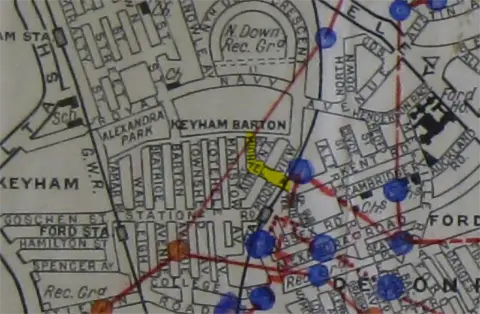UXO Mitigation for Renewable Energy Projects
This article explains the vital role of unexploded ordnance (UXO) risk mitigation for renewable energy projects, even in the most remote and unassuming of places.
Renewable Energy Projects
Since the turn of the century, renewable energy has become increasingly common in the UK due to a combination of policy initiatives, environmental goals, technological advancements, and utilisation of natural resources.
The Climate Change Act 2008 established a legally binding framework for reducing greenhouse gas emissions in the UK. Since then, a largescale initiative to establish low emission sources of power, such as solar and wind farms, has been put into effect across the UK.
Sites for solar and wind farms are often in rural and coastal areas, which people may not expect to be impacted by legacy UXO.
Why are renewable energy projects located rurally?
1) Land availability: renewable energy projects, such as wind and solar farms, require large amounts of land for the installation of turbines or panels. Rural, less developed land typically means more open space is available - compared to densely populated urban areas.
2) Lower land costs: land is generally less expensive than in urban or suburban areas, reducing the overall cost of a project.
3) Away from people: renewable projects can be considered unsightly or noisy, so where possible, they need to be constructed in areas away from urban development.
Why are rural areas in the UK susceptible to UXO contamination?
Many rural areas across the UK still remain at risk from potential UXO contamination for a number of reasons. Firstly, substantial areas of the country (approximately 20%) have been used for military training and live-firing exercises historically, resulting in buried and abandoned munitions.
Secondly, during World War II, the Blitz saw extensive bombing campaigns affect many UK towns and cities as well as rural ad coastal areas. Not all ordnance detonated as expected resulting in contamination from unexploded airdropped bombs across many areas of Britain.
Rural and coastal areas were especially susceptible to indiscriminate bombing known as ‘Tip and Run’ raids.
Finally, aircraft from World War II sometimes crashed in rural areas. These crashes could leave behind unexploded bombs or other ordnance that were on board the aircraft.
How can UXO impact the development of renewable energy projects?
The discovery of UXO can have a profound impact on project planning and development.
In the short term, unexpected UXO discoveries can halt construction activities until a site is cleared. Also, in the event of an encounter, UXO can pose a massive threat to the safety of workers and to the public.
Also, in the long-term, UXO emergency responses, delays and clearance operations can significantly increase project costs.
Igne’s typical UXO mitigation strategies for renewable projects explained:
Risk assessments: by evaluating the potential risks posed by UXO to a specific area for renewable development, we can often discount the need for additional unexploded ordnance related tasks. However, if we do identify risk, the following services remove that risk and protect your project.
Site surveys: we can conduct detailed surveys specific surveys to identify and map potential UXO locations.
Removal operations: safely removing and disposing of UXO using specialised equipment and trained personnel, we will ensure your site is ready for development and your programme of works can commence uninterrupted.
Examples of Igne successfully mitigating the risk of UXO on renewable energy projects:
Igne offers a turnkey solution for UXO risk mitigation and has extensive experience assessing the risk of UXO on numerous renewables projects. We have been an essential part of these projects, including the removal of various pieces of ordnance from several sites.
Here are some examples:
· 2012 – on a proposed wind farm in Berwickshire, numerous British live and expended projectiles were discovered during a non-intrusive magnetometry survey and target investigation by Igne (formally SafeLane). These were handed to the Royal Logistics Corps to be disposed of.
· 2016 - on a proposed windfarm in Yorkshire, a live mortar shell was discovered during a non-intrusive magnetometer survey and target investigation by Igne (formally SafeLane). This item was handed to the army and disposed of.
· 2022 – on a solar farm in Hampshire, several items of British small arms ammunition were discovered in a non-intrusive magnetometer survey and target investigation by Igne. These were disposed of by us.
· 2023 – we found and detonated eight 1kg German incendiary bombs on a future solar farm site in Essex.
· 2023 – while working on another solar farm development, Igne discovered the remains of a WWII B-17 aircraft crash, with small arms ammunition, on a site in Essex. These were removed and destroyed by us.
If you’re planning the development of a renewable energy farm anywhere in the UK including offshore, trust Igne for the comprehensive mitigation of potential risk from unexploded ordnance.
Other articles of interest

Expert Opinion for the BBC
As news coverage of the Plymouth bomb find continues, Igne's Explosive Ordnance Disposal (EOD) and research experts have been cited by the BBC and regional press, and have provided insight into what the Army may do next, and how insurers may involve an 'occasioned by war' clause to avoid paying out for any potential damage.

How Igne’s UXO risk assessments keep clients on time and budget
Igne’s research team create detailed UXO risk assessments so clients can determine the risk level of their sites.


